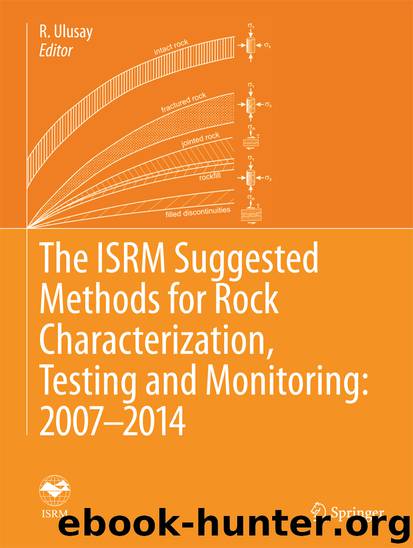The ISRM Suggested Methods for Rock Characterization, Testing and Monitoring: 2007-2014 by R. Ulusay

Author:R. Ulusay
Language: eng
Format: epub
Publisher: Springer International Publishing, Cham
7.1.2 Estimation of the Weathering Degree
Hachinohe et al. (1999) described the degree of weathering using the residual strength ratio (R s), which is the ratio of NPI of the weathered part to that of fresh (unweathered) part of rock cores.
(2)
where NPI is the measured value and NPIfp is an average value for the fresh part of each drill core. Based on the relationship between R s and the depth from the bedrock surface, these researchers indicated that R s decreases with increases in the weathering degree and that the longer the weathering time, the larger is the decrease in R s. Hachinohe et al. (1999) determined R s values from Tertiary sandstone and mudstone from the bedrock of marine terraces in Boso Peninsula, Japan. Recently, Aydan et al. (2013) correlated the degree of weathering of soft rocks utilizing the ratio of NPI values of weathered and unweathered soft rocks in a more quantitative manner.
Download
This site does not store any files on its server. We only index and link to content provided by other sites. Please contact the content providers to delete copyright contents if any and email us, we'll remove relevant links or contents immediately.
| Automotive | Engineering |
| Transportation |
Whiskies Galore by Ian Buxton(41541)
Introduction to Aircraft Design (Cambridge Aerospace Series) by John P. Fielding(32893)
Small Unmanned Fixed-wing Aircraft Design by Andrew J. Keane Andras Sobester James P. Scanlan & András Sóbester & James P. Scanlan(32580)
Craft Beer for the Homebrewer by Michael Agnew(17938)
Turbulence by E. J. Noyes(7717)
The Complete Stick Figure Physics Tutorials by Allen Sarah(7150)
Kaplan MCAT General Chemistry Review by Kaplan(6606)
The Thirst by Nesbo Jo(6450)
Bad Blood by John Carreyrou(6286)
Modelling of Convective Heat and Mass Transfer in Rotating Flows by Igor V. Shevchuk(6231)
Learning SQL by Alan Beaulieu(6043)
Weapons of Math Destruction by Cathy O'Neil(5853)
Man-made Catastrophes and Risk Information Concealment by Dmitry Chernov & Didier Sornette(5672)
Digital Minimalism by Cal Newport;(5397)
Life 3.0: Being Human in the Age of Artificial Intelligence by Tegmark Max(5198)
iGen by Jean M. Twenge(5168)
Secrets of Antigravity Propulsion: Tesla, UFOs, and Classified Aerospace Technology by Ph.D. Paul A. Laviolette(5005)
Design of Trajectory Optimization Approach for Space Maneuver Vehicle Skip Entry Problems by Runqi Chai & Al Savvaris & Antonios Tsourdos & Senchun Chai(4849)
Electronic Devices & Circuits by Jacob Millman & Christos C. Halkias(4756)
